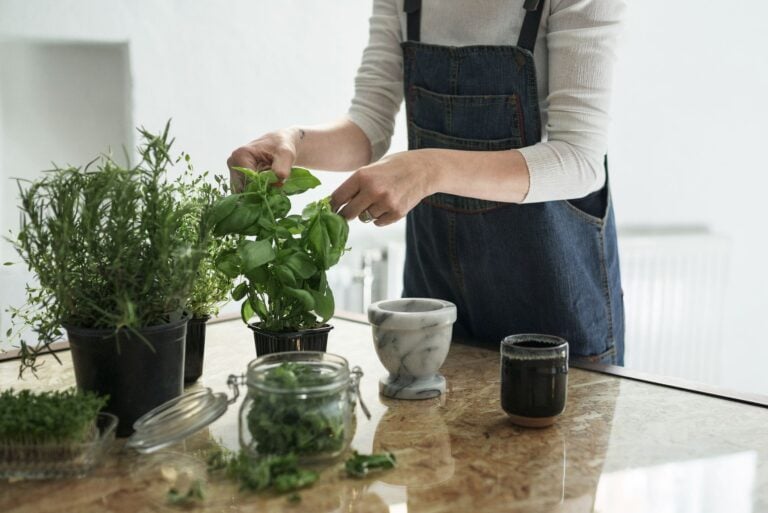23 Plants That Grow In Water
Some plants that grow in water don’t need any soil or potting. These plants are easy to care for and plant in fishbowls, glass jars, terrariums, or vases.
There are multiple different types of water plants that you can grow indoors.
For example, if you would like to extend your food, you can plant herbs that grow in water alone.
Or, if you’re going to decorate your home with natural plants, consider broad leaves and blooming water plants.
There are numerous benefits to water plants. They require minor maintenance, create almost no mess, and most of these plants are disease and pest-resistant.
Continue to find out 23 water plants that grow in water.
#1 Pothos
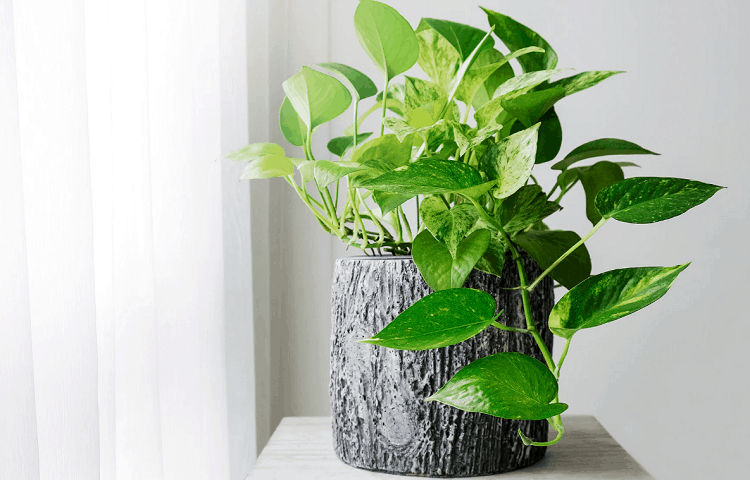
Pothos plants have heart-shaped, pointed, green leaves with white, yellow, or pale green markings.
Pothos don’t need much care to grow and provide a green cover inside the house as they don’t bloom flowers.
A Pothos plant can reach up to 6 to 10 feet tall and needs partial sunlight.
You can plant it the same way as the Philodendron. For fast growth, boost it with Miracle Grow liquid fertilizer.
Remove 2 or 3 leaves from the end of the stem and place this end in the water. Do not remove the leaves once roots and new leaves begin to show.
#2 Spider Plant
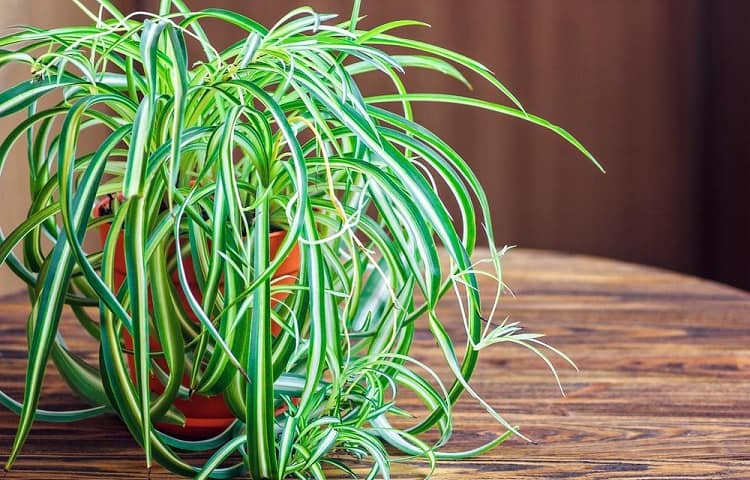
Spider plants have an attractive appearance and get their name from the distinctive markings on the leaves and their spider-like roots.
Spider plants are also one of the most rewarding plants that grow in water.
To grow a spider plant in water, inspect the root and trim down the excess root eight to ten inches in length.
Also, snip off any damaged or rotten roots, so they do not pollute the new growth.
Finally, to provide support and texture to the plant, pack the root with loose clean gravel and fill the new container with water.
This plant requires low care but keep it near a window, so it has a constant flow of clean air and plenty of light.
#3 Begonias
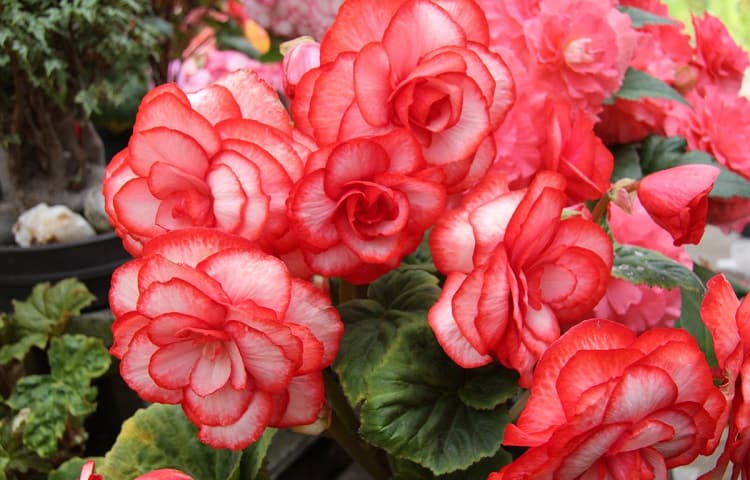
Begonias are beautiful flowering plants that grow in water containers. They have bright green leaves and lovely attractive flowers.
Some Begonias bloom non-stop and can grow in full sun or partial shade.
Begonias need warm temperatures to grow and bloom. Therefore, don’t place them in a dark or cold place.
Instead, keeping them near a window or in the living room should be enough to provide sufficient sunlight.
The Hardy Wax, Tuberous, and Rex Begonias grow from their roots in water and should enjoy tremendous growth in glass containers.
#4 Peace Lily
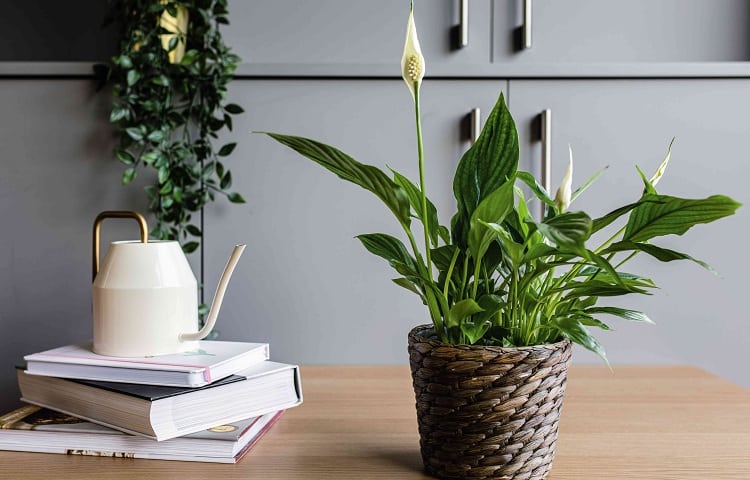
Peace Lilies are beautiful-looking flowers native to the rainforest in South America. Peace Lilies generate beautiful white flowers in the spring.
This plant blooms for two to three months and doesn’t need much sunlight to grow. As a result, Peace Lilies need little care and are known to clean the indoor air.
To grow a Peace Lily in water, remove it from the pot and clean the soil off the roots using lukewarm water.
Remove any overshoots or damaged roots and leave four or five leaves on the plant.
Keep the roots wholly submerged. After that, change the water every week.
Clean water aids Lily’s roots to absorb the nutrients as healthy plants that grow in water.
#5 Wandering Jew
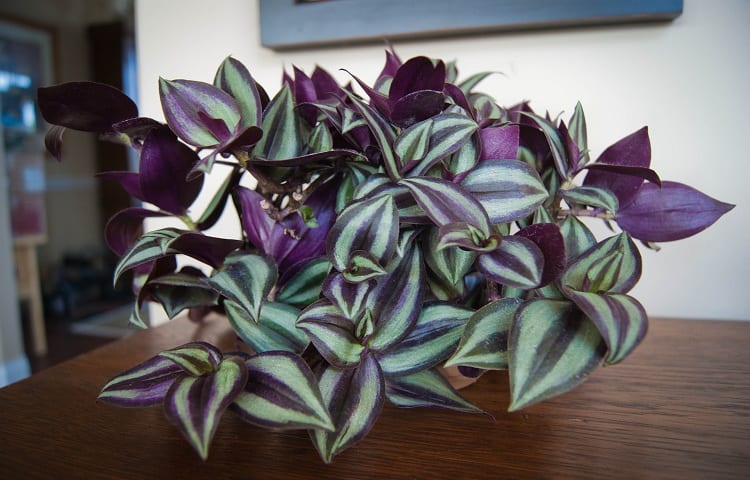
The Wandering Jew is a Tradescantia genus type of plant. They grow best under controlled temperatures of 65 – 75 °F in bright but indirect sunlight.
Wandering Jews are native to Central America and have lovely deep purple foliage.
You can plant 1 to 2 Wandering Jew stems in a narrow vase, or you can grow more in a bigger plant container.
Source of Wandering Jew and make a cut at the top of the upper stem, place the cutting in water, and keep it submerged until the new roots start forming.
You only need to provide this water plant with a bit of care by filling the container with water while the roots develop and strengthen.
#6 Lucky Bamboo
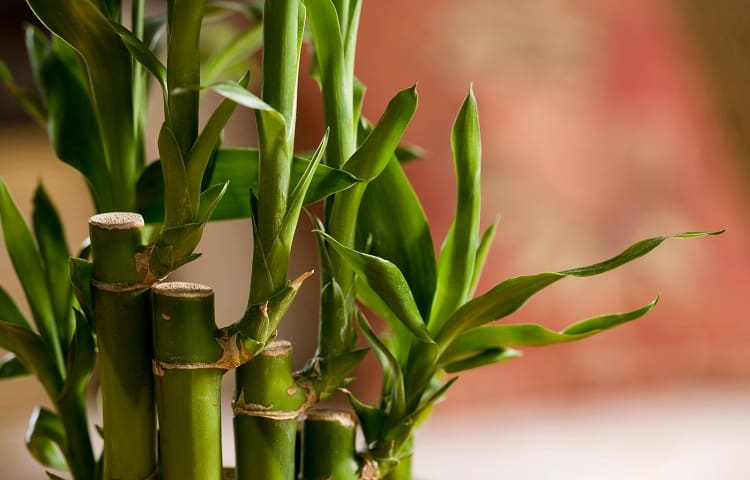
Lucky Bamboo is a non-bamboo member of the Dracaena Genus family.
It’s grown in Asia, and Feng Shui practitioners in China have used this plant for millennia to improve energy flows in spaces.
So people believe that keeping it in the house will bring them good luck.
The Lucky Bamboo doesn’t require much sunshine, so place it where it will receive a combination of indirect sunlight and shade throughout the day.
Unfortunately, direct sunlight can burn this plant’s leaves, slowing its growth.
Always use non-chlorinated water while growing Lucky Bamboo in water. You can also fill the tank with mineral water and change it every two or three weeks.
#7 Water Lily
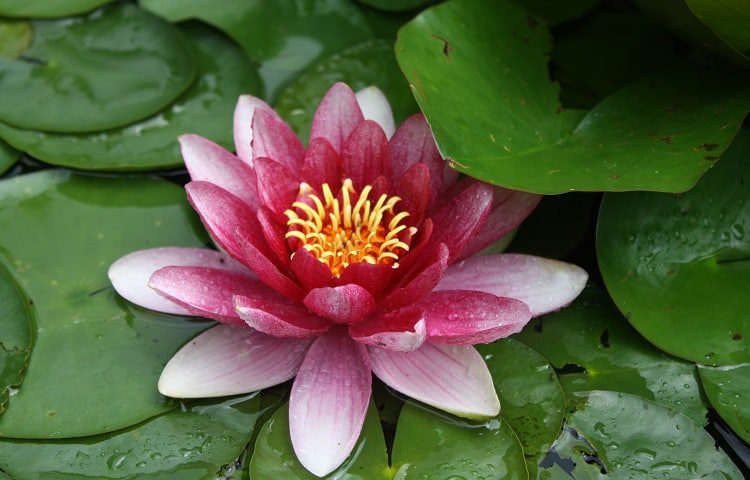
Water Lilies have rounded flat leaves and beautiful blossoming flowers and come in a variety of hues.
Water lilies are aquatic plants that only grow in water. These are great for aquariums, ponds, and interior water fountains.
Water lilies multiply and don’t need much care. There are two main species of the water lily, which are the hardy water lilies and tropical water lilies.
Hardy water lilies survive best in cold weather conditions, and tropical water lilies need a more moderate temperature, usually above 70°F.
To grow water lilies indoors, use a vessel that can hold around 15 to 25 gallons of water.
The larger bowl allows the leaves to spread and produce bigger flowers.
#8 Moses in the Cradle Plant
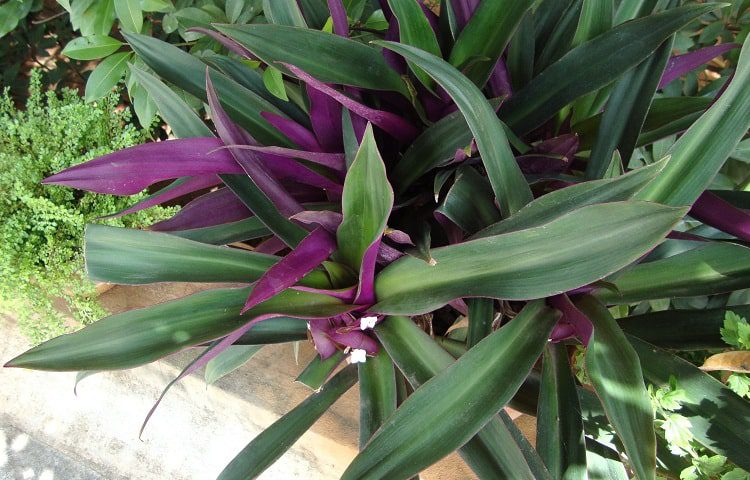
Moses in the Cradle is also known as the cradle lily or oyster plant.
Warm climates in Africa and Central America are home to these plants.
Long sword-shaped and leaves with a green and purple tint form part of this plant’s unique character.
As with many other plants that grow in water, the oyster plant thrives on full sunlight.
It produces tiny white flowers to brighten any living space, and you can either divide the plant or clip the stems to plant it.
First, cut the stem about 4 to 6 inches in length, leaving a couple of leaves on each piece.
This oyster plant is related to Wandering Jew and requires little care to develop.
#9 Paperwhite
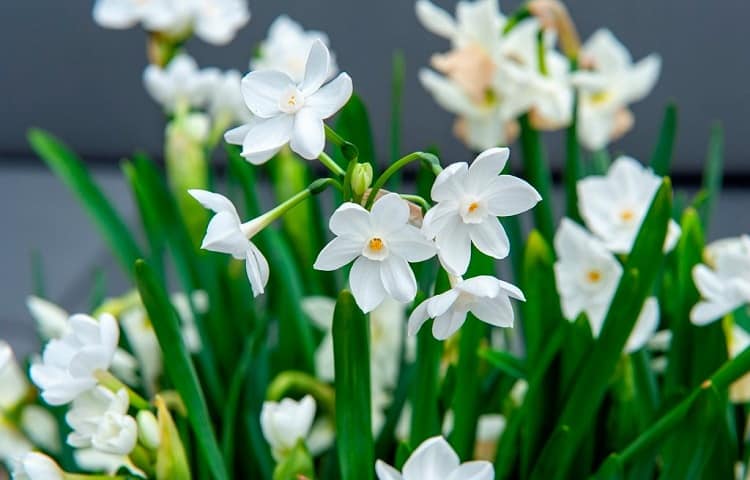
Paperwhite is another plant that grows quickly in water. You can plant the Paperwhite in a water vase where it produces a cluster of fragrant blooms.
To grow the Paperwhite in water, use a vase and fill it with two to four inches of freshwater.
You can place some rocks at the bottom of the container to support the Paperwhite bulbs.
Then group three or four Paperwhite bulbs with their roots facing downward.
Bulb deterioration is caused by overfilling or submerging them in water, so take caution when filling your vase.
The bulbs begin to grow roots after a few days. When they reach maturity, they will produce snowy-white blooms with a mildly perfumed flower.
As one of the more popular indoor plants, the Paperwhite plant requires very little maintenance.
#10 Celery
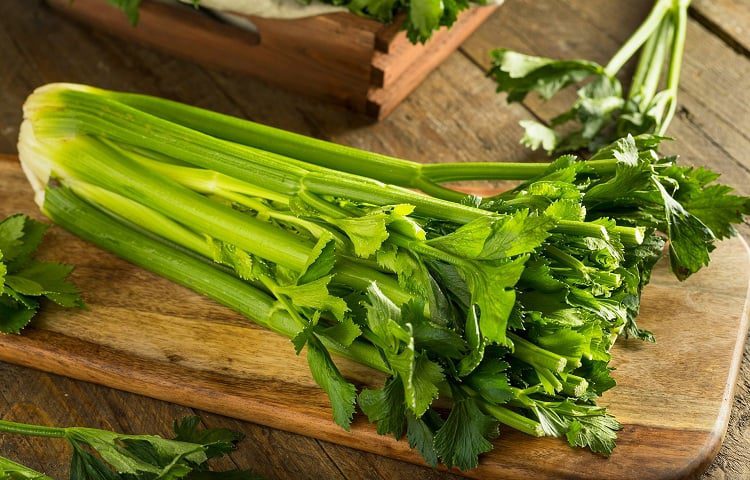
You can grow celery in water, but this plant grows slowly.
However, if you want to add to your herb collection with this vegetable, you’ll set yourself up for some delicious extra food flavors.
First, clip a 3- or 4-inch stalk from the fresh celery and set it half-submerged in water.
Then, place the container in the sun and change the water every couple of days to ensure that the celery receives enough nutrients and minerals.
#11 Lemongrass
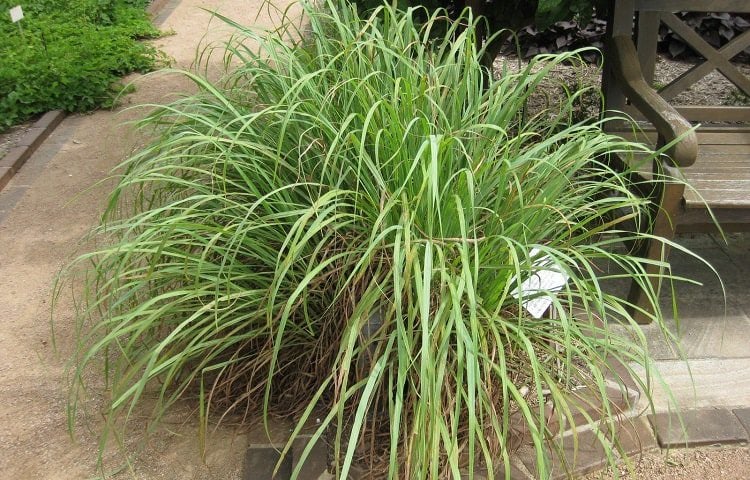
Another popular herb is Lemongrass. It inhibits the growth of germs and yeast while also relieving pain and swelling.
You can grow Lemongrass in the soil or the water. Lemongrass is another plant that grows in water with a few cuttings.
Cut the bottoms of the Lemongrass stems 5 to 6 inches long and set them in the water basin.
Keep half of the length above the water’s surface to avoid submerging it completely.
Place the container where it will receive adequate sunshine and replace the water every few days.
You can use a liquid fertilizer to speed up the growth of these and other plants that grow in water.
It will probably only be a few days before you get to see the tiny roots emerging.
#12 Chinese Evergreen
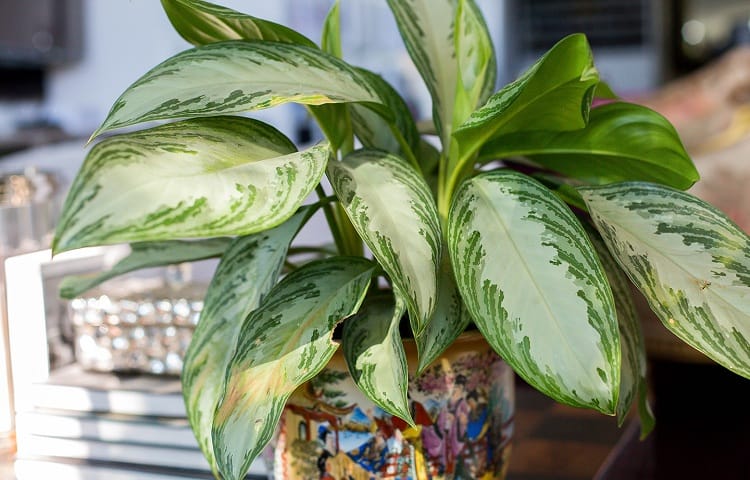
Chinese Evergreen or Agalonemas has broad leaves. Evergreens grow to a height of 3 to 10 inches in a medium amount of time and require moderate sunlight.
However, you can place it in a lesser light environment, and it will grow normally.
Cut around the 6-inch stems and insert them in the water pot to grow your Chinese Evergreen.
During the summer and blooming season, treat the plant with a liquid fertilizer every two weeks.
#13 Rosemary
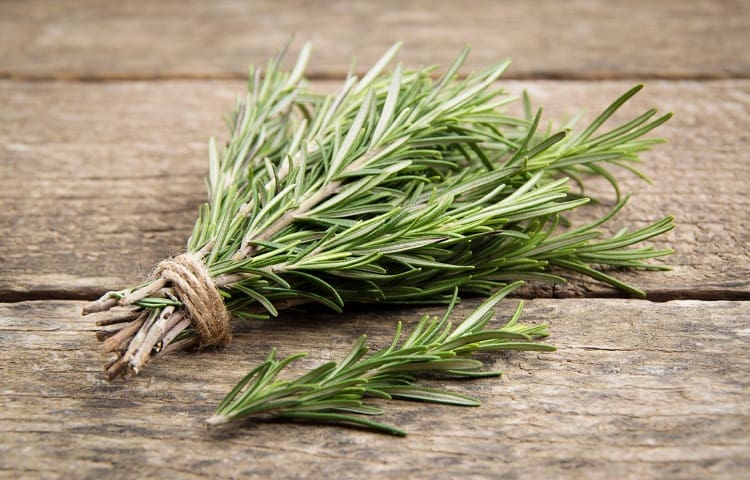
If you enjoy growing herbs, you’ll enjoy growing organic Rosemary indoors as even this plant grows in water.
Rosemary blooms with blue flowers and is a perennial plant.
Cut a three-inch fresh stem from the existing rosemary plant to cultivate Rosemary in water.
Remove the lowest leaves that lie beneath the water and place the plant in a sunny area with indirect light.
Remove and replace the water every two weeks as clean water inhibits the growth of algae, which stifles the development of the Rosemary roots.
#14 Oregano
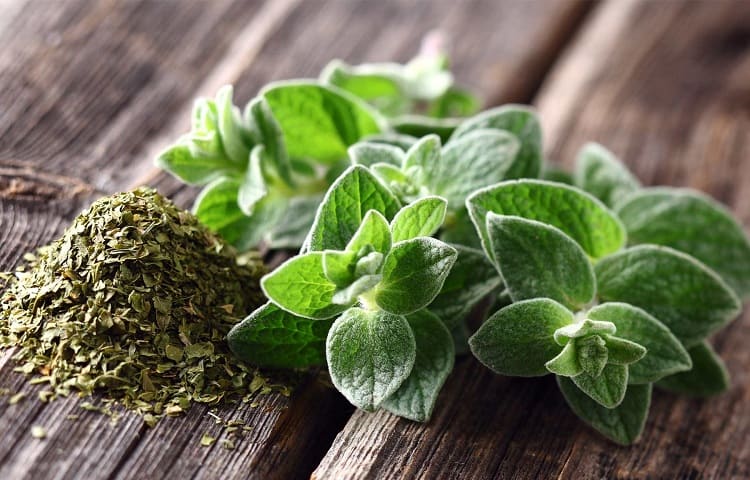
Oregano is a familiar medicinal herb from the Mint or Lamiaceae family.
People frequently use oregano in meals because of its anti-inflammatory properties. Oregano is also an easy plant that grows in water.
Take off the leaves from the lower half of a healthy oregano plant stem, around 4–6 inches long.
This method prevents the leaves from becoming rotten and contaminating the water when you place the stem in a jar.
To maintain the water’s cleanliness and ensure it remains full of nutrients, change it every three or four days.
The roots should begin to grow in a few days. Always use tap water rather than distilled water as distilled water is nutrient-poor, whereas tap water is the opposite.
Oregano is a water plant that grows well in water but only if the water contains sufficient nutrition to sustain new and ongoing healthy growth.
#15 English Ivy
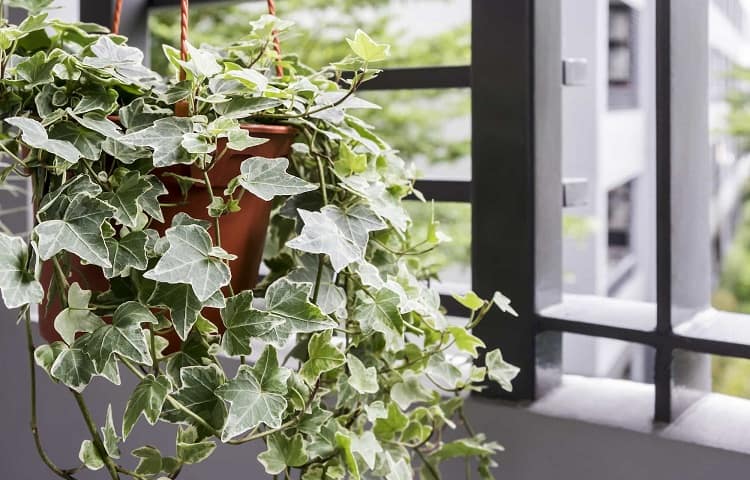
English ivy is a great wall and building cover. It has dense green leaves with light veins meant for climbing, and this plant does not produce flowers.
You should cut the Ivy stems above the triangular fold for propagation. These angular folds run between the stems of the leaves.
Next, remove the leaves from the bottom of the Ivy stem and fill the pot with non-chlorinated water.
You can also use bottled water if you choose. Place the leafless bottom section of the stem in water and place the container in a warm, somewhat sunny location.
Change the water every alternate day, and the Ivy will begin to sprout new roots in a few days.
#16 Arrowhead
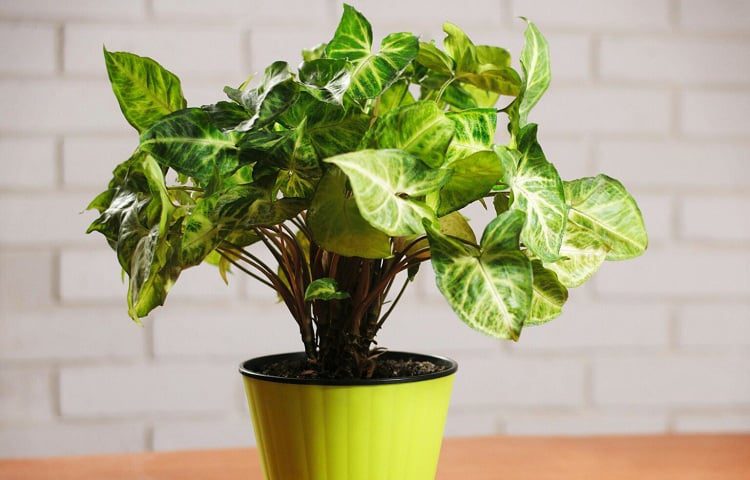
Arrowhead plants are lovely whole-leaf plants that thrive in damp environments like the jungle.
These plants are climbers that prefer to grow on walls or other plants.
The Arrowhead can be grown via air layering or division cutting. Because it is easier to root in water, division cutting is preferable for planting in water.
Once you plant it in the water container, place it in a position to receive light but no direct sunlight.
Because the Arrowhead plant is tropical, it thrives in wet, humid conditions.
Therefore, its growth is aided by growing it in water and placing it in a well-lit, warm place.
#17 Coleus
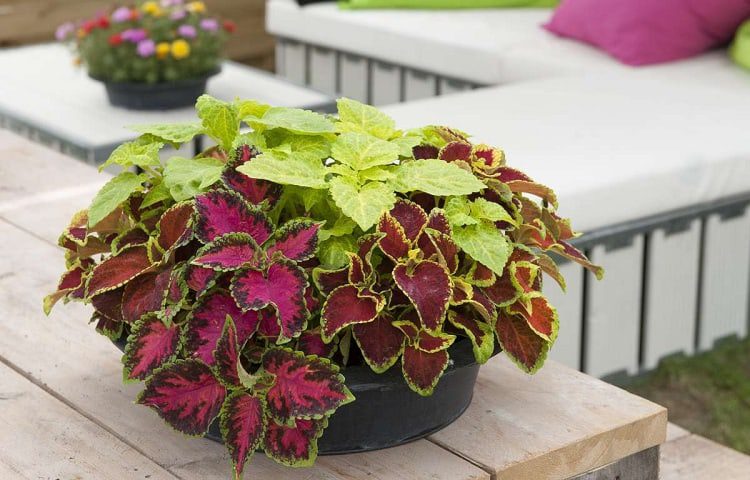
Coleus is one of the few species that can be grown in pots and requires little maintenance.
In addition, the roots grow fast, which makes them perfect for growing in water.
Coleus can be grown from seeds or existing plants. Snipping the stem from a healthy Coleus plant reduces the amount of time it takes for the plant to grow.
Remove the plant’s 3 to 5-inch stems and the majority of the lower leaves, leaving only a few on top.
Place the stem in a container filled with water, but keep the leaves out of the water.
Place the vase near a window or anywhere where it will receive indirect light. In a week or two, the plant’s roots begin to grow.
Once the plant has enough roots, it begins to thrive.
#18 Cladophora Moss Ball
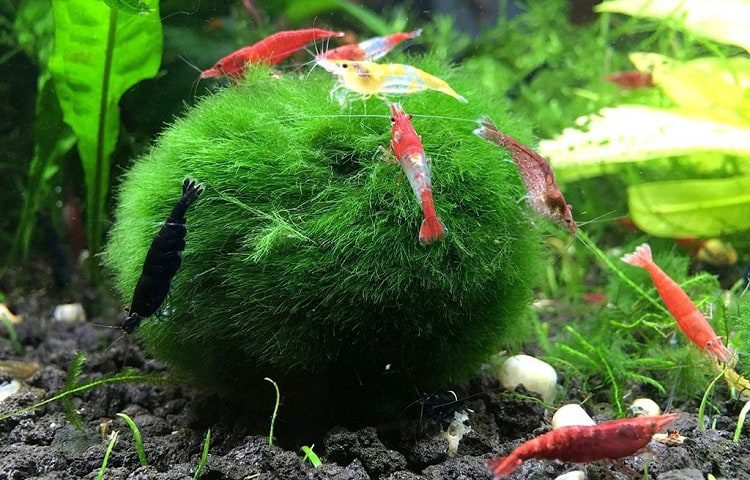
The Cladophora Moss Ball, also known as the Marimo Moss Ball, is a Japanese native.
You will often see Cladophora in aquariums, where they grow well in water and thrive without rotting.
You don’t have to devote plenty of time to care for the Cladophora because it can live for several years with minimum care.
However, if any brown spots show up on the plant after placing it in the aquarium, turn it around to face the light.
Avoid direct sunlight as these are sensitive plants, and direct exposure can damage them.
Adding lights, plant fertilizer, and a pinch of salt in the water also spurts their growth and kills algae that may attach to the Marimo Moss Ball.
#19 Philodendron
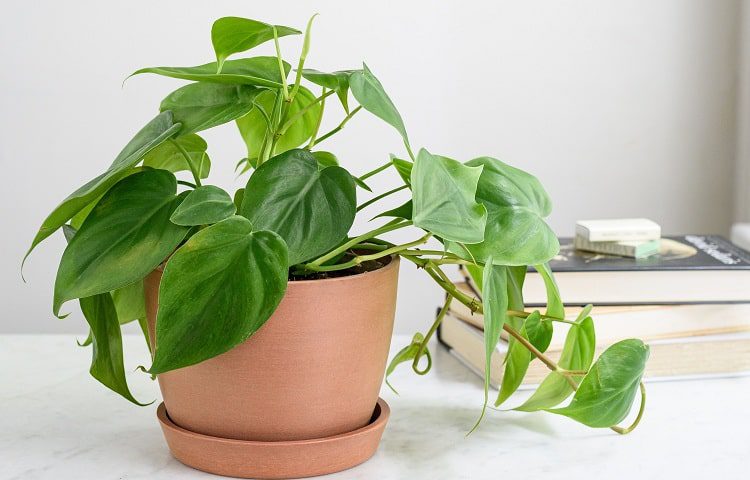
The Philodendron is the easiest plant that grows in water, making care a simple process.
The two main types of species of this plant are vines and non-climbers. The vine can rise around the garden or home walls and windows.
The non-climbers have lush, broad green leaves.
To grow a philodendron in water, cut about six inches from the stem, keeping a few leaves, and expose two or three nodes on the stem.
Then place the side where you extracted the leaves under the water.
Keep changing the water every 3 to 4 days. In about two weeks, the roots start growing.
Next, place the Philodendron where it can get indirect sunlight.
#20 Lotus
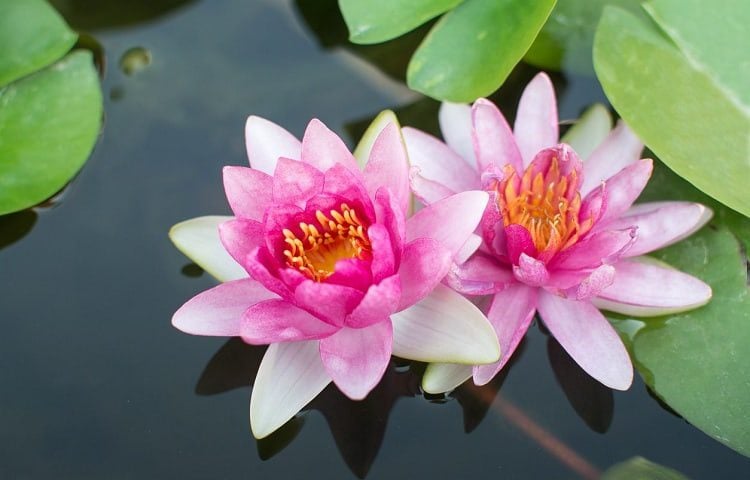
The Lotus is an Australian and Asian plant that grows in water. The flower comes in a variety of shapes and hues, including pink and white.
The Lotus thrives in shallow, muddy water with plenty of sunlight.
Fill a container halfway with garden soil to cover the rhizomes while leaving the pointed tips exposed to grow the Lotus.
Then, pour enough water into the container to cover about 2 inches of the soil.
Finally, place small stones on top of the rhizomes to keep them from losing their moorings.
The leaves will begin to grow in a few days. Add more water to immerse the roots continuously.
The plant grows and is ready to bloom after a few days.
#21 Impatiens
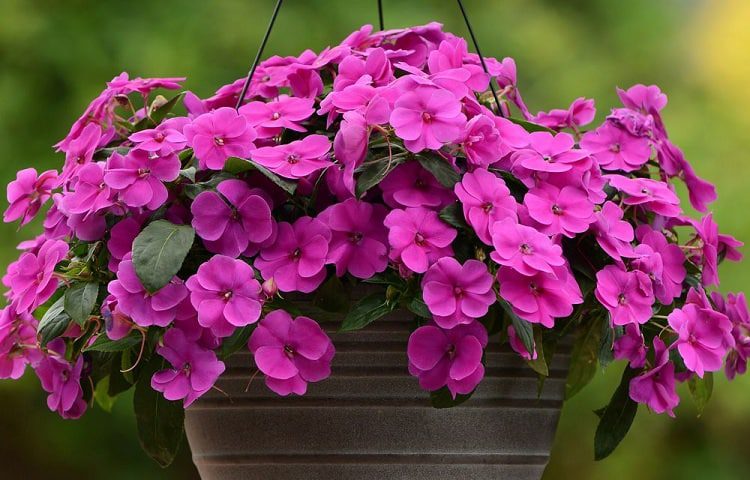
Impatiens produce lovely multicolored flowers, making them ideal for indoor décor.
This plant, commonly known as “Busy Lizzie,” prefers shady and partially sunny locations and is one of the most colorful plants that grow in water.
To grow Impatiens in water, cut a stem off the plant. Remove all the except a few at the top to preserve the node.
Put the stem in the water container but do not submerge the leaves completely.
Place the plant container where it will receive partial sunshine instead of direct sunlight.
Throw out the murky water every few days and replace it with fresh water.
After a few weeks, the plant begins to root, and once enough roots have grown, it begins to grow and blossom.
#22 African Violet
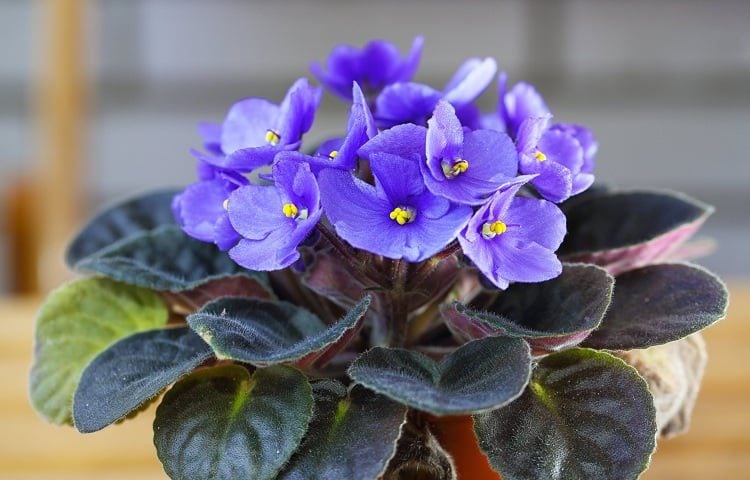
The African Violet is a vibrant plant that is temperature sensitive and prefers water with a mild temperature to flourish.
It’s possible that putting it in cold water will kill this plant. Instead, place the plant in partial sunshine to avoid getting wet on the leaves.
Its leaf is where the African Violet grows. Pick a mature, healthy leaf from the African violet’s center, with about 1 inch of petiole below the foliage.
Allow the loaf to sit in the air for about an hour before submerging it in water. It promotes root growth at a rapid rate.
Change the water every several days, and the roots will begin to develop from the petiole after a time. It begins to bloom once it has reached full maturity.
#23 Jade Plant
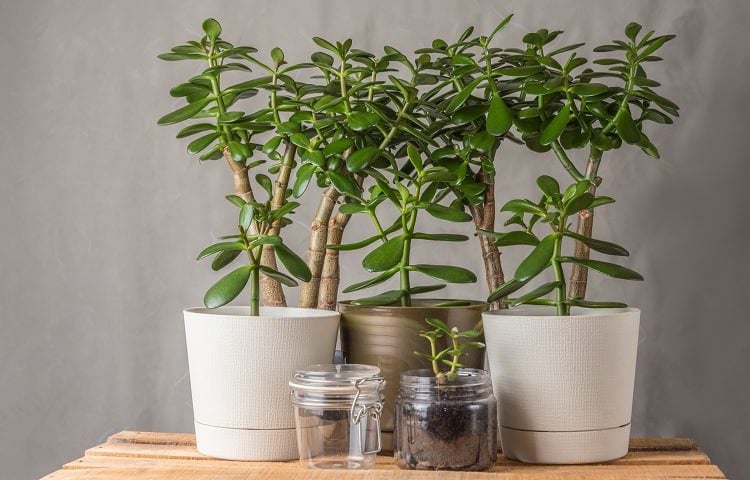
Jade plants are also known as Crassula and generate succulent or cactus-like leaves.
These leaves have a lustrous appearance and robust stalks that can reach a height of 5 feet.
The Jade plant is low-maintenance and can thrive in a variety of environments.
Cut the stem of the Jade plant and pluck 2 to 3 inches of leaves from the stem.
Fill a container halfway with water and submerge the Jade Plant in the water. In a few days, your plant will begin to form roots.
As with all the other plants that grow in water, it is necessary to change it regularly to provide this plant with sufficient nutrition.
Also, changing the water helps avoid the rotting of new roots, which will kill new growth.
Final comments
Hydrophytes and Macrophytes are plants that grow in water. These plants can either immerse in the water or float on top of it.
Plants that grow in water often adapt to exist in saltwater or freshwater environments.
In simple terms, plants that grow in water are called aquatic plants.
Hydroponics is the term for growing these plants in water without any need for soil as a growth medium.
Resources:

